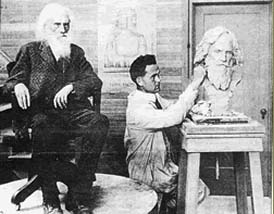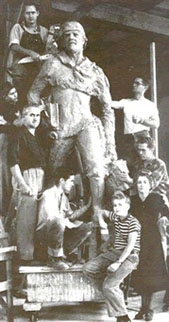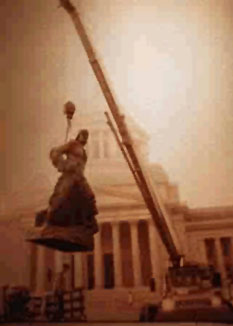History
excerpt from A Sculptor's Testimony in Bronze and Stone by Eugene F. Fairbanks
Internationally renowned for historical monuments and classic works of art,
Avard Fairbanks spent seventy years devoting his life to preserving history,
telling stories, and teaching through his artwork. From Classic Greek to
Western American Buffalo his works transcend centuries of timeless
Imagination.
A doctor of anatomy, he paid scrupulous attention to anatomical detailing. This made him one of the world's best realists of his time. Each piece of his was created from the inside out, from skeleton to muscle system to the
fine creases in skin. He put into each creation such a sense of concern, whether tragic or happy, that one can feel the significance of each event recorded. So life-like is each statue, that it was said, "if given a spirit, the subject could get up and walk away."
"Young Michaelangelo"
Born in a small town in Utah to John B. and Lilly Annetta Huish Fairbanks,
he had an early exposure to the world of art. His father was a teacher at
the Brigham Young Academy (now Brigham Young University) who had an excellent reputation as a mural painter and as a teacher. His success as an artist and professor was an inspiration to Avard to follow a similar path.
At the early age of twelve he modeled a pet rabbit which won first place in
The Utah State Fair. When the judge found the winner to be a young boy of only
twelve years, he refused to award the medal. This act of thoughtlessness
made the young Avard determined to do even better work and to become a truly
Accomplished artist. And this he did.
John B. went to New York City to make copies of masterpieces at the
Metropolitan Museum for private sale. Avard followed him soon thereafter to
help. Because of his youth the curator was reluctant to grant him a permit
to copy the sculpture. When he saw the marvelous work that Avard did, he
apologized for his reticence. Soon an article appeared in the New York
Times titled, "Young Michaelangelo of this modern day in knickerbockers
working at the Metropolitan Museum." This article attracted a lot of
attention and brought him new opportunities. While fourteen years of age
his work was displayed in the National Academy of Design. In 1910 he was
offered a scholarship to study at the Art Students League at New York under
James Earl Fraser.
Early International Acclaim
Trying to promote sculpture to earn enough money to study artwork in Paris,
Avard and his father struggled to save enough money to be able to accomplish
this dream. One year Avard offered to model a lion in butter for a local
creamery exhibit at the State Fair. This attracted a large crowd and the
manager was well pleased. This brought attention to the Fairbanks' artwork
and enough sales were made so that Avard could study abroad.
In 1913 he went to study at the Ecole Nationale des Beaux Artes under
Injalbert. While in Paris, he studied at the Ecole de la Grande Chaumiere,
at the Academy Colarossi, and at the Grand Salon. His artwork was exhibited
at the Grand Salon. Although he intended to continue in Paris, the outbreak
of World War I forced him and his father to return to the States.
Penniless, he returned to Salt Lake City to finish his high school
education.
At the close of World War I he created monuments to memorialized the men who
fought in that war. The Idaho Doughboy was cast and placed in two cities
in Idaho. He made bas relief panels for the Oregon State University in
Corvalis, for Jefferson High School in Portland, and bronze-paneled doors
for the U.S. National Bank, also in Portland. Later a memorial to The
Ninety-first Division was erected at Fort Lewis, Washington. This was one
of his finest.
Finishing His Education
Eventually studying at Yale University, he completed his Bachelor's Degree in Fine
Arts. Soon thereafter the Guggenheim awarded him a fellowship
Foundation which enabled him to go to Europe with his wife and four sons to
study and do creative sculpture. He studied under Dante Sodini and at the
Scuola Fiorentina de Pittura. While there he created The Pioneer Mother
Memorial and had it cast in bronze. This was placed in Vancouver,
Washington. He also carved Motherhood out of marble.
From 1920 to 1924 he taught sculpture at the University of Oregon. While there he created monuments for the Oregon Trail Association. These were placed in Baker and Seaside, Oregon.
After earning a Master's Degree in Fine Art, he joined the faculty of the University of Michigan. Teaching and studying simultaneously, he turned his attentions to the field of anatomy. He was awarded a Master of Arts degree in 1933 and in 1936, a Doctor of Philosophy degree in anatomy.
In preparation for his degree in Anatomy he modeled reconstructions of the musculature of the head, neck, arms, legs and torso. Plaster casts of these now hang on the anatomy laboratory walls at the University of Michigan, and the art departments of the University of Utah and Brigham Young University.
Many of his great monuments were created during these eighteen years at the University of Michigan. Nebula and Rain, exhibited at the Northwest Flower Show in Detroit, Tragedy at Winter Quarters, Madonna and Child, and Christ Among the Doctors are a few of them. Several portraits of Lincoln and other illustrious individuals were also modeled then.

|
Education
- 1910. Art Students League, New York City, New York.
- 1914. Ecole Nationale des Beaux Arts, Paris, France
- 1914. Academie Colarossi, Paris, France
- 1914. Ecole de La Grande Caumiere, Paris, France
- 1917. University of Utah, Salt Lake City, Utah
- 1918 BFA. Yale University, Connecticut
- 1927. Scuola Fiorentina de Pittura, Florence, Italy
- 1929 MFA. University of Washington, Washington
- 1933 MA. University of Michigan, Michigan>
- 1936 PhD. University of Michigan, Michigan
Fellowships and Awards
- Herbert Adams, Medal of Honor, National Sculptural Society
- Guggenheim Memorial Fellowship
- Doctor of Fine Arts, Lincoln College
- Lincoln Diploma of Honor, Lincoln Memorial University
- Medal of Lycurgus
- Academician, Accademia Italia delle Arti
- Honorary citizen of Sparta, Greece
- Medal of the Knight of Thermopylae
- Fellow, International Arts and Letters, Zurich
- Fellow, Protetore della Contrada della Torre da Siena
Industry, Professorship and Continued Artistry

At the close of World War II, emphasis was given to civilian needs. Because of Michigan's automotive industry needs, Avard was asked to collaborate with the Automotive Engineers to teach industry with regard to the arts. His abilities as a designer were recognized by the greatest manufacturers of our day. He designed hood ornaments for the Dodge Company (the Ram) and the Plymouth Company (the Griffin). He also created an award given to the Pioneers of the Auto Industry entitled The Genius of Man.
The University of Utah was also expanding in the Post World War II period. Dr. Fairbanks was appointed Dean and asked to organize a college of fine arts at this institution. He moved is family of ten to Salt Lake City in 1947, where he was to remain for the rest of his life.
He continued to create masterful artwork. Requests for great monuments continued to keep him quite busy. He continued in his studies of Abraham Lincoln and created several new monuments placed in Chicago and Berwyn, Illinois. Marble portrait busts representing four periods of his life were placed in the Ford Theater Museum in Washington, D.C. (See Abraham Lincoln Sculpture Created by Avard T. Fairbanks.)
Avard was also commissioned to do several monuments for the L.D.S. Church. Joseph's First Vision, The Restoration of the Priesthoods, The Angel Moroni which tops the Washington D.C, Seattle, Jordan River, and Mexico City temples are among the most recognized by Church members. (See A Sculptor's Testimony in Bronze and Stone. Sacred Sculpture by
Avard T. Fairbanks..)
Travelling back and forth to Italy, overseeing casting of his pieces kept him and his family quite occupied. Lycurgus, the Law Giver was dedicated in Sparta in 1955. While there he found two young girls needing a home. Because their children were all boys, he and his wife, Maude requested to adopt them. This increased their family to twelve. They were thrilled to have two daughters.
In addition to his creative endeavors, he constantly sought to extend the influence of fine art to the public. He gave demonstration lectures to high schools, garden clubs, professional women's clubs, medical societies, service clubs, art guilds, church groups, and college faculty meetings. He has appeared on television on several occasions. These demonstrations were instructional as well as entertaining. His ease with making clay come alive was a thrill to all who attended his lectures. (See Creating a Portrait in Sculpture.)
Avard T. Fairbanks lived to be almost ninety years old. He died in January, 1987, leaving a legacy of artistic genius. His work is a monument to his love of the fine arts, a love he shared with all.
 |



